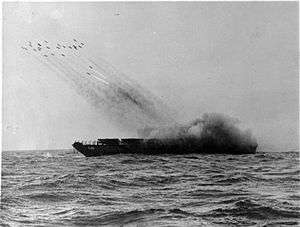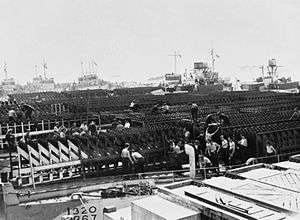Landing Craft Tank (Rocket)
The Landing Craft Tank (Rocket) or LCT(R) was developed from the British Mk.2 and Mk.3 Landing Craft Tank (LCT) during the Second World War. It was designed to saturate beaches with up to 1,066 RP-3 60 lb rockets prior to the landing of troops. Used by both British and U.S. forces, the craft saw service in the Normandy landings, the Mediterranean and the Far East.


_459.png)
Design
The front loading door was welded shut and an additional deck installed above the tank storage bay to provide a mounting for the rocket launching racks. The resulting storage space below the deck (formerly the tank deck) was informally subdivided with canvas sheets to provide additional crew space. These were later updated with wooden partitions. The craft was also fitted with a Type 970 radar set whose primary use was for rangefinding, but was also successfully used for navigation. Generally propulsion was provided by Paxman diesel engines, however, others were used due to availability. Some U.S. craft were fitted with petrol (gasoline) engines.
Application
The batteries of 5-inch rocket projectors carried by each LCT(R) fired salvoes of rockets in rapid succession, triggered electronically by an officer located in the bridge wheelhouse. The remainder of the seventeen man crew took shelter, at the point of firing, in the below-deck space described above. The projectors were cordite filled tubes, firing 7lb high explosive heads. As the individual LCT(R) moved towards the beach or other target area the approximately twenty-four salvoes could in theory blanket an area of up to 1,000 yards in depth.
External links
| Wikimedia Commons has media related to Landing Craft Tank (Rocket). |
- "British Landing Craft of World War II". navyhistory.org.au. Retrieved 14 January 2011.
- "U.S. Navy Landing Craft Tank (Rocket)". combinedops.com. Retrieved 14 January 2011.